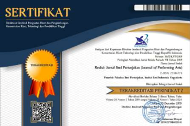Kèjhungan: Gaya Nyanyian Madura dalam Pemaknaan Masyarakat Madura Barat pada Penyelenggaraan Tradisi Rèmoh
Zulkarnain Mistortoify, Timbul Haryono, Lono L. Simatupang, Victorius Ganap
Abstract
Kèjhungan in Rèmoh Tradition on West Madura. Kèjhungan or singing style comes from the activity of peoplesinging about their everyday lives in Madura’s society. When the kèjhungan has become an “established” singing style,therefore the meaning of the kèjhungan includes the ownership meaning that is inherited through oral traditions andlegitimized in the culture of the people of Madura. The research’s assumption explains that the existence of the kèjhunganbecomes an important conscious for the whole singing culture of the Madura people. Even, in the elite village life for examplein the “gathering tradtion” of blatèr community, kèjhungan has become their identity of existence. This research is a studyon the representation of values when the kèjhungan is made as a symbol or legitimate image for the blatèr communityin the Madura society. The fi ndings of this research explains that kèjhungan has become the object of consumption thatis advanced to the blatèr community in achieving their respect. With their power, the blatèr can construct traditionalkèjhungan values into outstanding symbols in strengthening their existence in Madura’s society.
Keywords
blatèr community - meaning – kèjhungan - rèmoh tradition.
DOI:
https://doi.org/10.24821/resital.v11i1.488
Refbacks
- There are currently no refbacks.

This work is licensed under a Creative Commons Attribution 4.0 International License.



